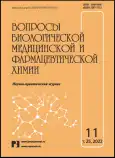Влияние гормонального состава питательной средыи эндогенных полифенолов на формирование каллусной ткани Ipomoea batatas (L.)
- Авторы: Калашникова Е.А.1, Киракосян Р.Н.1, Абубакаров Х.Г.1, Зайцева С.М.1
-
Учреждения:
- Российский государственный аграрный университет - МСХА имени К.А. Тимирязева
- Выпуск: Том 25, № 11 (2022)
- Страницы: 46-58
- Раздел: Статьи
- URL: https://bakhtiniada.ru/1560-9596/article/view/143404
- DOI: https://doi.org/10.29296/25877313-2022-11-08
- ID: 143404
Цитировать
Аннотация
Актуальность. Ipomoea batatas (L.) – ценная сельскохозяйственная культура, в клубнеплодах которой накапливается инулин, природный полисахарид, не имеющий синтетических аналогов. В производстве функциональных продуктов питания российские производители, как правило, используют импортный инулин. Глобализация, информационная революция, а также санкционная политика обострили существенные проблемы мировой экономики, что повышает актуальность импортозамещения ряда товаров и продуктов. Известно, что холодовой стресс является одним из основных факторов окружающей среды, ограничивающих сельскохозяйственное производство. Низкие положительные температуры негативно влияют на рост, развитие, продуктивность и урожай растений I. batatas (L.). Создать стрессоустойчивые растения можно с использованием методов клеточной биотехнологии, в частности, клеточной селекции in vitro, которая проводиться на каллусной ткани, культивируемой в стрессовых условиях.
Цель исследования – оценка влияния гормонального состава питательной среды и эндогенных полифенолов на формирование каллусной ткани батата (I. batatas (L.)) in vitro.
Материал и методы. Объект исследования – три сорта I. batatas (L.) (Пурпл, Jewel, Порто Рико). Каллусную ткань получали из сегментов листовых пластинок и междоузлий стебля, которые изолировали из асептических растений батата. Экспланты культивировали на питательной среде МС, содержащей БАП 0,5 мг/л и 1 мг/л НУК/ ИУК/ 2,4-Д. Локализацию фенольных соединений изучали в листьях, стеблях, апикальных почках микроклонов батата, а также в каллусной ткани, полученной на питательной среде с разными ауксинами. Для этого применяли гистохимические методы: на сумму фенольных соединений материал окрашивали 0,08% растром реактива Fast Blue, для изучения локализации флаванов (катехины и проантоцианидины) использовали реакцию с ванилиновым реактивом в парах соляной кислоты.
Ключевые слова
Полный текст
Открыть статью на сайте журналаОб авторах
Е. А. Калашникова
Российский государственный аграрный университет - МСХА имени К.А. Тимирязева
Автор, ответственный за переписку.
Email: kalash0407@mail.ru
д.б.н., профессор, кафедра биотехнологии
Россия, МоскваР. Н. Киракосян
Российский государственный аграрный университет - МСХА имени К.А. Тимирязева
Email: mia41291@mail.ru
к.б.н., доцент, кафедра биотехнологии
Россия, МоскваХ. Г. Абубакаров
Российский государственный аграрный университет - МСХА имени К.А. Тимирязева
Email: khrpo95@mail.ru
аспирант, кафедра биотехнологии
Россия, МоскваС. М. Зайцева
Российский государственный аграрный университет - МСХА имени К.А. Тимирязева
Email: smzaytseva@yandex.ru
к.б.н, доцент, кафедра биотехнологии
Россия, МоскваСписок литературы
- Franck A. Technological functionality of inulin and oligofruc-tose. Br. J. Nutr. 2002; 87: S287–S291.
- Kumar J., Rani K., Datt C. Molecular link between dietary fibre, gut microbiota and health. Mol. Biol. Rep. 2020; 47: 6229–6237.
- Sabater-Molina M., Larqué E., Torrella F., Zamora S. Dietary fructooligosaccharides and potential benefits on health. J. Physiol. Biochem. 2009; 65: 315–328.
- Ahmed W., Rashid S. Functional and therapeutic potential of in-ulin: A comprehensive review. Crit. Rev. Food Sci. Nutr. 2019; 59: 1–13.
- Saeed F., Pasha I., Arshad M.U., Anjum F.M., Hussain S., Rasheed R., Nasir M.A., Shafique B. Physiological and nutraceutical perspectives of fructan. Int. J. Food Prop. 2015; 18: 1895–1904.
- Shoaib M., Shehzad A., Omar M., Rakha A., Raza H., Sharif H.R., Shakeel A., Ansari A., Niazi S. Inulin: Properties, health benefits and food applications. Carbohydr. Polym. 2016; 147: 444–454.
- Shang H.M., Zhou H.Z., Yang J.Y., Li R., Song H., Wu H.X. In vitro and in vivo antioxidant activities of inulin. PLoS ONE. 2018; 13: 19–22.
- Namanda S., Gibson R.W., Kirimi S. Sweet potato seed systems in Uganda, Tanzania and Rwanda. Journal of Sustainable Agriculture. 2011; 35: 870–884.
- Ogero K.O., Gitonga N.M., Mwangi M., Ombori O., Ngugi M. A low-cost medium for sweet potato micro propagation. African Crop Science Conference Proceedings. 2011; 10: 57–63.
- Cha-um S., Kirdmanee C. Diseases free production of sugar-cane varieties (Saccharum officinarum L.) using in vitro meri-stem culture. Biotechnology. 2006; 5(4): 443–448.
- Doliñski R., Olek O. Micropropagation of sweet potato (Ipo-moea batatas (L.) Lam.) from node explants. Acta Sci Pol., Hortorum Cultus. 2013; 12(4): 117–127.
- Liu Q.C., Zhai H., Wang Y., Zhang D.P. Efficient plant regener-ation from embryonic suspension cultures of sweet potato. In vitro Cell Developmental Biology-Plant. 2001; 37: 564–567.
- Murashige T., Skoog F. A revised medium for rapid growth and bioassays with tobacco tissue cultures. Physiol. Plant. 1962; 15: 473–497.
- Soukupova J., Cvikrova M., Albrechtova J., Rock B.N., Eder J. Histochemical and Biochemical Approaches to the Study of Phenolic Compounds and Peroxidases in Needles of Norway Spruce (Picea abies). New Phytol. 2000; 146: 403–414.
- Лакин Г.Ф. Биометрия: учеб. пособие для биол. спец. вузов. М.: Высшая школа. 1990. 352 с.
- Дубравина Г.А., Зайцева С.М., Загоскина Н.В. Изменения в образовании и локализации фенольных соединений при де-дифференциации тканей тисса ягодного и тисса канадского в условиях in vitro. Физиология растений. 2005; 52: 755–762.
- Запрометов М.Н. Фенольные соединения и их роль в жизни растения. LVI Тимирязевские чтения. М.: Наука. 1996. 45 с.
- Тулупова Е.С., Остроженкова Е.Г., Слепян., Саканян Е.И. Влияние различных цитокининов на рост селективных штаммов Panax ginseng С.А.Меу и Panax quinquefolius L. с герматраном Lx 5 и содержание в них гликозидов. Биотех-нология. 2002; 3: 30–36.
- Калашникова, Е.А., Зайцева С.М., Доан Тху Тхуи, Киракосян Р.Н. Влияние регуляторов роста на морфогенетическую ак-тивность экспланотов Dioscorea nipponica Makino и образо-вание полифенолов. Международный научно-исследовательский журнал. 2020; 6-2(96): 6–11.
Дополнительные файлы





















